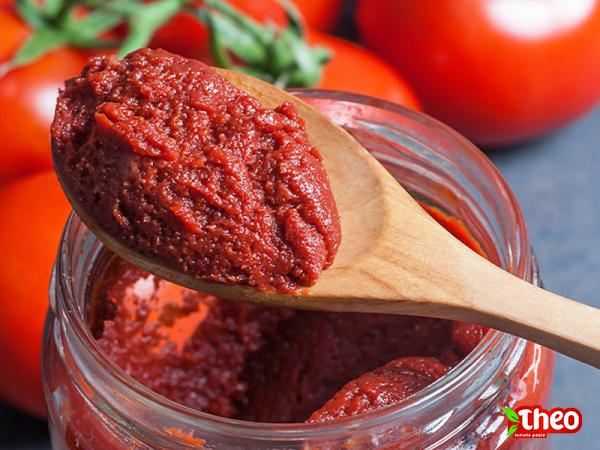Comparing Tomato Paste and Ketchup: Finding the Best Price Introduction: Tomato paste and ketchup are popular condiments that are widely used in various culinary applications. While both products feature tomatoes as their primary ingredient, they have distinct differences in terms of taste, texture, and usage. This article aims to provide a comprehensive comparison between tomato paste and ketchup, focusing on their production process, nutritional differences, and pricing. By understanding these factors, consumers can make informed decisions when it comes to purchasing these products and finding the best price. 1. Tomato Paste: Tomato paste is made by cooking tomatoes for an extended period to remove water content, resulting in a thick, concentrated tomato puree. The process involves crushing the tomatoes, straining the seeds and skin, and then cooking the remaining pulp to evaporate excess moisture. The resulting paste is dense, deep red, and has an intense, concentrated tomato flavor. Tomato paste serves as an important ingredient in various dishes, including stews, soups, sauces, and marinades, adding richness and depth to the flavor profiles. 2. Ketchup: Ketchup, on the other hand, is a condiment that is commonly used as a flavor-enhancer for a range of dishes, particularly burgers, fries, and hot dogs. Ketchup consists of tomato paste, vinegar, sweeteners, spices, and other additives, giving it a sweeter and tangier taste compared to tomato paste. It is known for its smooth and pourable texture, making it convenient for drizzling or dipping. 3. Nutritional Differences: When comparing the nutritional value of tomato paste and ketchup, it is important to note that significant differences exist due to variations in ingredients. Tomato paste has a higher concentration of tomatoes, which results in a more significant amount of essential nutrients such as vitamins A, C, and K, as well as minerals like potassium and iron. Additionally, tomato paste has a lower sugar content compared to ketchup, making it a healthier option for those conscious of their sugar intake. On the other hand, ketchup tends to have higher sodium content due to the addition of salt and other flavoring agents. 4. Production Process and Cost: The production process for tomato paste involves several steps, including sourcing quality tomatoes, harvesting, washing, and sorting. After processing the tomatoes into a liquid state, excess moisture is reduced through evaporation, resulting in the thick paste. This meticulous process, along with the high-quality standards, influences the cost of tomato paste production. Ketchup production, on the other hand, involves the incorporation of various ingredients such as vinegar, sweeteners, and spices to create the desired flavor profile. Additionally, ketchup undergoes more processing steps compared to tomato paste, including mixing, cooking, and bottling. The addition of these ingredients and additional processing steps can contribute to a higher production cost overall.

tomato paste
 5. Cost Comparison: When comparing the cost of tomato paste and ketchup, it is essential to consider factors such as brand, quality, packaging size, and location. Generally, tomato paste tends to be more affordable than ketchup on a per-ounce basis. However, it is worth noting that the price difference may vary depending on the brand, store, and specific packaging options available. Consumers looking for the best price should evaluate various options, including purchasing in bulk or choosing store-brand alternatives. These strategies can help reduce overall costs, especially for those who frequently use tomato paste or ketchup in larger quantities. 6. Considerations for Best Price: To find the best price for tomato paste or ketchup, it is crucial to consider the following factors: a. Store Brands: Often, store-brand options provide competitive prices without compromising quality. Explore different store brands available in your region and compare their prices and ingredients. b. Bulk Buying: Purchasing larger quantities of tomato paste or ketchup can often lead to cost savings. Look for sales or discounts on bulk purchases, particularly if you use these products frequently or require them for commercial purposes. c. Comparison Shopping: Consider comparing prices across multiple stores to find the most affordable option. Online shopping platforms can also be helpful in finding the best deals. d. Coupons and Promotions: Keep an eye out for coupons or promotional offers from manufacturers or retailers. These can provide additional discounts and help you save money on your purchases. Conclusion: Tomato paste and ketchup serve unique purposes in culinary applications, with tomato paste bringing intense flavor and richness while ketchup offers a sweeter tang. Due to their distinct production processes and nutritional profiles, the prices of tomato paste and ketchup can vary. When seeking the best price, it is essential to consider factors such as store brands, bulk buying, comparison shopping, and promotional offers. By utilizing these strategies, consumers can find affordable options for their tomato paste and ketchup needs, ensuring both their taste buds and wallets are satisfied.Title: Comparing Tomato Paste and Ketchup: Finding the Best Price 1. Understanding Consumer Preferences: In the competitive condiment market, understanding consumer preferences is crucial for businesses looking to offer the best price for tomato paste and ketchup. Conducting market research, such as surveys or focus groups, can provide valuable insights into consumer preferences and buying behaviors. This data can help businesses tailor their offerings and pricing strategies to meet customer demands effectively.
5. Cost Comparison: When comparing the cost of tomato paste and ketchup, it is essential to consider factors such as brand, quality, packaging size, and location. Generally, tomato paste tends to be more affordable than ketchup on a per-ounce basis. However, it is worth noting that the price difference may vary depending on the brand, store, and specific packaging options available. Consumers looking for the best price should evaluate various options, including purchasing in bulk or choosing store-brand alternatives. These strategies can help reduce overall costs, especially for those who frequently use tomato paste or ketchup in larger quantities. 6. Considerations for Best Price: To find the best price for tomato paste or ketchup, it is crucial to consider the following factors: a. Store Brands: Often, store-brand options provide competitive prices without compromising quality. Explore different store brands available in your region and compare their prices and ingredients. b. Bulk Buying: Purchasing larger quantities of tomato paste or ketchup can often lead to cost savings. Look for sales or discounts on bulk purchases, particularly if you use these products frequently or require them for commercial purposes. c. Comparison Shopping: Consider comparing prices across multiple stores to find the most affordable option. Online shopping platforms can also be helpful in finding the best deals. d. Coupons and Promotions: Keep an eye out for coupons or promotional offers from manufacturers or retailers. These can provide additional discounts and help you save money on your purchases. Conclusion: Tomato paste and ketchup serve unique purposes in culinary applications, with tomato paste bringing intense flavor and richness while ketchup offers a sweeter tang. Due to their distinct production processes and nutritional profiles, the prices of tomato paste and ketchup can vary. When seeking the best price, it is essential to consider factors such as store brands, bulk buying, comparison shopping, and promotional offers. By utilizing these strategies, consumers can find affordable options for their tomato paste and ketchup needs, ensuring both their taste buds and wallets are satisfied.Title: Comparing Tomato Paste and Ketchup: Finding the Best Price 1. Understanding Consumer Preferences: In the competitive condiment market, understanding consumer preferences is crucial for businesses looking to offer the best price for tomato paste and ketchup. Conducting market research, such as surveys or focus groups, can provide valuable insights into consumer preferences and buying behaviors. This data can help businesses tailor their offerings and pricing strategies to meet customer demands effectively.
Specifications of tomato paste
 2. Branding and Packaging: In the world of condiments, branding and packaging play a significant role in attracting customers and influencing their purchasing decisions. Brands that invest in attractive packaging, informative labels, and compelling marketing campaigns are likely to have higher perceived value. While established brands may charge a premium for their products, store brands or lesser-known brands might offer similar quality at a more affordable price point. 3. Supply Chain Optimization: For businesses involved in the production and distribution of tomato paste and ketchup, optimizing the supply chain can help reduce costs and offer competitive prices to customers. Streamlining processes, eliminating inefficiencies, and forging strong relationships with suppliers can lead to cost savings. Additionally, identifying opportunities for vertical integration, such as growing tomatoes, can help businesses exert more control over the entire supply chain, leading to cost reduction benefits. 4. Relationship with Suppliers: Developing and nurturing strong relationships with suppliers is crucial for businesses looking to offer the best price for tomato paste and ketchup. Long-term partnerships can lead to favorable pricing agreements, volume discounts, and improved access to high-quality ingredients. Maintaining open communication, regular assessments of supplier performance, and exploring alternative sourcing options can also contribute to cost savings. 5. Sustainable Sourcing and Cost Considerations: As sustainability becomes increasingly important to consumers, businesses should explore sustainable sourcing options for tomatoes used in tomato paste and ketchup production. Sourcing from local farmers or implementing organic farming practices can have multiple benefits, including potential cost savings through reduced transportation and marketing expenses. Additionally, ethical and sustainable sourcing practices resonate with consumers, enhancing brand reputation and potentially justifying a higher price point. 6. Quality Control: Ensuring consistent quality is critical for businesses offering tomato paste and ketchup. Implementing rigorous quality control measures and obtaining necessary certifications can justify higher prices for premium products. This may involve regular testing for product consistency, adherence to food safety standards, and conducting customer satisfaction surveys to assess product quality and meet consumer expectations. 7. Marketing and Promotions: Effective marketing and promotional strategies can influence consumer perception of value and drive purchasing decisions. Offering promotions, such as buy-one-get-one-free deals or discounts, can attract price-sensitive customers while generating higher volumes of sales. Collaborating with retailers for in-store promotions or leveraging digital marketing channels can help reach a wider audience and increase brand visibility, ultimately contributing to higher sales and better pricing opportunities.
2. Branding and Packaging: In the world of condiments, branding and packaging play a significant role in attracting customers and influencing their purchasing decisions. Brands that invest in attractive packaging, informative labels, and compelling marketing campaigns are likely to have higher perceived value. While established brands may charge a premium for their products, store brands or lesser-known brands might offer similar quality at a more affordable price point. 3. Supply Chain Optimization: For businesses involved in the production and distribution of tomato paste and ketchup, optimizing the supply chain can help reduce costs and offer competitive prices to customers. Streamlining processes, eliminating inefficiencies, and forging strong relationships with suppliers can lead to cost savings. Additionally, identifying opportunities for vertical integration, such as growing tomatoes, can help businesses exert more control over the entire supply chain, leading to cost reduction benefits. 4. Relationship with Suppliers: Developing and nurturing strong relationships with suppliers is crucial for businesses looking to offer the best price for tomato paste and ketchup. Long-term partnerships can lead to favorable pricing agreements, volume discounts, and improved access to high-quality ingredients. Maintaining open communication, regular assessments of supplier performance, and exploring alternative sourcing options can also contribute to cost savings. 5. Sustainable Sourcing and Cost Considerations: As sustainability becomes increasingly important to consumers, businesses should explore sustainable sourcing options for tomatoes used in tomato paste and ketchup production. Sourcing from local farmers or implementing organic farming practices can have multiple benefits, including potential cost savings through reduced transportation and marketing expenses. Additionally, ethical and sustainable sourcing practices resonate with consumers, enhancing brand reputation and potentially justifying a higher price point. 6. Quality Control: Ensuring consistent quality is critical for businesses offering tomato paste and ketchup. Implementing rigorous quality control measures and obtaining necessary certifications can justify higher prices for premium products. This may involve regular testing for product consistency, adherence to food safety standards, and conducting customer satisfaction surveys to assess product quality and meet consumer expectations. 7. Marketing and Promotions: Effective marketing and promotional strategies can influence consumer perception of value and drive purchasing decisions. Offering promotions, such as buy-one-get-one-free deals or discounts, can attract price-sensitive customers while generating higher volumes of sales. Collaborating with retailers for in-store promotions or leveraging digital marketing channels can help reach a wider audience and increase brand visibility, ultimately contributing to higher sales and better pricing opportunities.
buy tomato paste
 8. Product Differentiation: To find the best price for tomato paste and ketchup, businesses must consider opportunities for product differentiation. Identifying unique selling points, such as organic ingredients, reduced sodium content, or novel flavor profiles, can justify a higher price point and attract a niche market segment. By offering a product that stands out from competitors, businesses can position themselves as premium brands and potentially charge a higher price for their tomato paste or ketchup. 9. Customer Loyalty Programs: Implementing customer loyalty programs can be an effective strategy for businesses to retain existing customers and encourage repeat purchases. Rewarding customers for their loyalty through exclusive discounts, personalized offers, or free samples can contribute to customer satisfaction and promote brand loyalty. By engaging customers in long-term relationships, businesses can secure a consistent customer base and potentially justify higher prices for their tomato paste and ketchup products. 10. Industry Collaboration: Collaborating with industry organizations and associations can provide businesses with access to valuable resources, networking opportunities, and market insights. By staying informed about market trends, pricing strategies, and industry best practices, businesses can make informed decisions regarding pricing for their tomato paste and ketchup products. Sharing knowledge and experiences with peers can contribute to collective growth and identify innovative ways to offer the best price to consumers. 11. E-commerce Opportunities: With the rise of e-commerce platforms, businesses can leverage online marketplaces to reach a broader customer base and offer competitive prices. E-commerce eliminates the need for physical storefronts, reducing overhead costs and allowing for more flexibility in pricing strategies. Moreover, online platforms provide the opportunity to collaborate with third-party logistics providers, further optimizing supply chain costs and efficiencies. 12. Consumer Education: Educating consumers about the differences between tomato paste and ketchup, such as their nutritional profiles and usage recommendations, can influence their purchasing decisions. Businesses can provide informative content through their websites, social media channels, or product packaging, highlighting the benefits of their products and justifying their pricing. By building trust and fostering transparency, businesses can position themselves as trusted sources of information and encourage customers to choose their products based on value rather than just price. Conclusion: To offer the best price for tomato paste and ketchup, businesses need to understand consumer preferences, optimize supply chain processes, build strong supplier relationships, and differentiate their products. By implementing effective branding, packaging, marketing, and promotions, businesses can attract customers and justify their pricing. Collaboration within the industry, exploring e-commerce opportunities, and educating consumers about the value of their products can further contribute to success in the competitive condiment market. By considering these factors and implementing the suggested strategies, businesses can navigate the market and find the best price for their tomato paste and ketchup offerings.
8. Product Differentiation: To find the best price for tomato paste and ketchup, businesses must consider opportunities for product differentiation. Identifying unique selling points, such as organic ingredients, reduced sodium content, or novel flavor profiles, can justify a higher price point and attract a niche market segment. By offering a product that stands out from competitors, businesses can position themselves as premium brands and potentially charge a higher price for their tomato paste or ketchup. 9. Customer Loyalty Programs: Implementing customer loyalty programs can be an effective strategy for businesses to retain existing customers and encourage repeat purchases. Rewarding customers for their loyalty through exclusive discounts, personalized offers, or free samples can contribute to customer satisfaction and promote brand loyalty. By engaging customers in long-term relationships, businesses can secure a consistent customer base and potentially justify higher prices for their tomato paste and ketchup products. 10. Industry Collaboration: Collaborating with industry organizations and associations can provide businesses with access to valuable resources, networking opportunities, and market insights. By staying informed about market trends, pricing strategies, and industry best practices, businesses can make informed decisions regarding pricing for their tomato paste and ketchup products. Sharing knowledge and experiences with peers can contribute to collective growth and identify innovative ways to offer the best price to consumers. 11. E-commerce Opportunities: With the rise of e-commerce platforms, businesses can leverage online marketplaces to reach a broader customer base and offer competitive prices. E-commerce eliminates the need for physical storefronts, reducing overhead costs and allowing for more flexibility in pricing strategies. Moreover, online platforms provide the opportunity to collaborate with third-party logistics providers, further optimizing supply chain costs and efficiencies. 12. Consumer Education: Educating consumers about the differences between tomato paste and ketchup, such as their nutritional profiles and usage recommendations, can influence their purchasing decisions. Businesses can provide informative content through their websites, social media channels, or product packaging, highlighting the benefits of their products and justifying their pricing. By building trust and fostering transparency, businesses can position themselves as trusted sources of information and encourage customers to choose their products based on value rather than just price. Conclusion: To offer the best price for tomato paste and ketchup, businesses need to understand consumer preferences, optimize supply chain processes, build strong supplier relationships, and differentiate their products. By implementing effective branding, packaging, marketing, and promotions, businesses can attract customers and justify their pricing. Collaboration within the industry, exploring e-commerce opportunities, and educating consumers about the value of their products can further contribute to success in the competitive condiment market. By considering these factors and implementing the suggested strategies, businesses can navigate the market and find the best price for their tomato paste and ketchup offerings.




